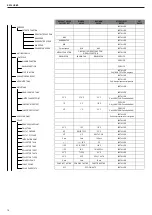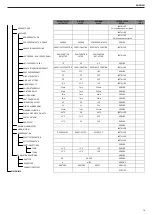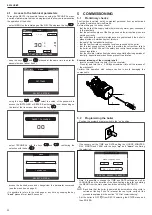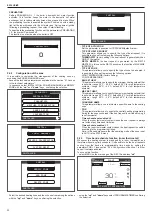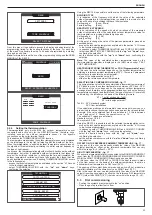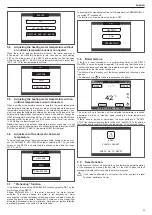
11
ENGLISH
It is obligatory to make the connection with a safe ground/earth, in
compliance with current directives.
b
To ensure the tightness of the boiler, use a self-locking cable tie and
tighten it on the fair lead used.
b
It is the responsibility of the installer to provide suitable grounding
for the appliance; the manufacturer will not be liable for any damage
resulting from an incorrect or absent earth connection.
b
It is also recommended to uphold the phase-neutral connection (L-N).
b
The earth conductor must be a couple of cm longer than the others.
The boiler can operate with a phase-neutral or not floating phase-phase
supply.
It is forbidden to use gas and/or water pipes to earth electrical appliances.
Use the power cable supplied to connect the boiler to the mains power
supply. If the power cable has to be replaced, use a HAR H05V2V2-F cable,
3 x 0.75mm
2
, Ø max external 7 mm.
3.6 Gas connection
The connection of the gas supply must be carried out in compliance with
current installation standards.
Before carrying out the connection, check that the type of gas is that for
which the appliance is set up.
3.7 Removing the casing
To access the components inside, remove the casing as indicated below:
- locate and unscrew the 2 screws (
A
- fig. 13) that fix the casing to the
boiler
- by leveraging the fixing clips (
C
- fig. 13), unhook the lower part of the
casing
- lift the casing upwards to release it from the top tabs (
B
- fig. 13), then
remove it.
WARNING
b
In case of removal of the side panels, reassemble them in the initial
position by referring to the adhesive labels on the side walls.
b
The possible damage of the frontal panel involves the replacement
of the same.
b
The noise absorbing panels inside the front and side walls ensure
the airtight seal for the air supply duct in the installation environment.
b
It is therefore ESSENTIAL after the dismantling operations to
correctly reposition the components so as to ensure boiler tightness.
3.8 Flue gas exhaust and combustion air suction (fig. 15)
To evacuate the combustion products, refer to UNI 7129-7131. Always
comply with local standards of the Fire Department, the Gas Company and
with possible municipal dispositions.
The release of combustion products is assured by a centrifugal fan and the
control board constantly checks that it is operating correctly. It is essential
for evacuating fumes and adduction boiler combustion air that only original
pipes are used (except for C6 type) and that the connection is made correctly
as shown in the instructions provided with the flue gas accessories.
A single flue can be connected to several appliances provided that every
appliance is the condensing type.
The boiler is a C-type appliance (with airtight chamber), and must therefore
have a safe connection to the flue gas discharge pipe and to the combustion
air suction pipe; these both carry their contents outside, and are essential
for the operation of the appliance.
Both concentric and twin terminals are available.
Suction/discharge pipes length table
Maximum straight length
Pressure drop
25C
30C
35C
bend
45°
bend
90°
Flue gases pipe
Ø 80 mm (“forced
open” installation)
(type B23P-B53P)
125 m
90 m
60 m
1 m
1,5 m
Concentric pipe
Ø 60-100 mm
(horizontal)
10 m
10 m
8 m
1,3 m
1,6 m
Concentric pipe
Ø 60-100 mm (vertical)
11 m
11 m
9 m
1,3 m
1,6 m
Concentric pipe
Ø 80-125 mm
25 m
25 m
20 m
1 m
1,5 m
Twin pipe Ø 80 mm
70+70 m 50+50 m 35+35 m
1 m
1,5 m
b
“Straight length” means with terminals and joints but without bends.
b
The boiler is supplied without the flue gas outlet/air suction kit, since
it is possible to use the accessories for condensing appliances that
better adapt to the installation characteristics (see catalogue).
b
The maximum lengths of the pipes refer to the flue accessories
available in the catalogue.
b
It is compulsory to use specific pipes.
b
The non insulated flue gas outlet pipes are potential sources of
danger.
b
The use of a longer pipe causes a loss of output of the boiler.
b
Make sure the flue gas discharge pipe is tilted 3° towards the boiler.
b
The discharge pipes can be fitted in most suitable direction in relation
to installation requirements.
b
As envisaged by current legislation, the boiler is designed to take
in and dispose of flue gas condensate and/or meteoric water
condensate deriving from the flue gas discharge system using its
own siphon.
b
If a condensate relaunch pump is installed, check the technical
data (provided by the manufacturer) regarding output, to ensure it
operates correctly.
“Forced open”
Installation (type B23P/B53P)
In this configuration the boiler is connected to the ø 80 mm flue gases
discharge pipe by means of an adaptor.
- Position the adaptor so that the Ø 60 pipe goes fully into the flue gases
turret of the boiler.
- Once positioned, make sure that the 4 notches (
A
) on the flange connect
to the groove (
B
) on the Ø100 of the adaptor.
- Fully close the screws (
C
) that tighten the two locking terminals of the
flange so the adaptor itself is restrained.
Concentric pipes (ø 60-100 mm)
- Position the bend so that the Ø 60 pipe goes fully into the flue gases
turret of the boiler.
- Once positioned, make sure that the 4 notches (
A
) on the flange connect
to the groove (
B
) on the Ø100 of the bend.
- Fully close the screws (
C
) that tighten the two locking terminals of the
flange so the bend itself is restrained.
Twin pipes (ø 80 mm)
The combustion air suction pipe should be selected from the two inputs,
remove the closing plug fixed with the screws and fix the specific air
deflector.
- Position the adaptor on the flue gases pipe so that the Ø 60 pipe goes
fully into the flue gases turret of the boiler.
- Once positioned, make sure that the 4 notches (
A
) on the flange connect
to the groove (
B
) on the Ø100 of the adaptor.
- Fully close the screws (
C
) that tighten the two locking terminals of the
flange so the adaptor itself is restrained.
Refer to the graphs (fig .18) to find the maximum lengths of the single pipe.
When using the
twin pipe kit from Ø60-100mm to Ø80-80mm
instead of
twin pipe system, there will be a loss in the maximum lengths as shown in
the table.
Ø50
Ø60
Ø80
Length loss (m)
0,5
1,2
5,5
Concentric pipes (ø 80-125 mm)
- Position the adaptor so that the Ø60 pipe goes fully into the flue turret
of the boiler.
- Once positioned, make sure that the 4 notches (
A
) on the flange connect
to the groove (
B
) on the Ø100 of the adaptor.
- Fully close the screws (
C
) that tighten the two locking terminals of the
flange so the adaptor itself is restrained.
- Then fit the Ø 80-125 adaptor kit on the vertical fitting.
Содержание EXCLUSIVE C
Страница 101: ... ...


















